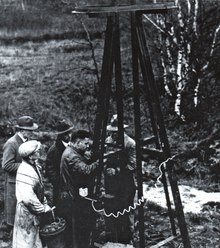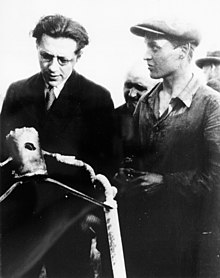Paul Ehmayr


Paul Ehmayr (born October 28, 1909 in Vienna , † 1993 in Linz on the Danube ; also incorrectly spelled as Ehmayer, Ehmeier or Ehmeyer) was a German-Austrian rocket engineer . He was a trained precision mechanic . His masterpiece was a barometer .
Life
Due to the high unemployment in Austria , Ehmayr went to Mecklenburg in 1927 , then on to Berlin . From 1930 he worked there as part of the engineering team around Hermann Oberth , Rudolf Nebel and Klaus Riedel (together with Wernher von Braun , Rolf Engel , Hans Bermüller , Hans Hüter , Kurt Heinisch and Helmuth Zoike ) in development, especially in construction and on the experiments with the first rockets powered by liquid gas .
Development and tests initially took place in the Chemisch-Technische Reichsanstalt , financially supported by the Heereswaffenamt . When Hermann Oberth went back to Romania , the team continued its activities at the newly established rocket airfield in Berlin- Reinickendorf. The launch frame and the rocket components that had previously been developed by Fritz Lang for the film " Woman in the Moon " were used. The jointly developed rockets included the Oberth cone nozzle , various variants of the repulsor , the Mirak I-III and the Magdeburg launch device (10-L) .
The activities of the Association for Space Travel and at the Berlin rocket airfield have been under strict surveillance since the National Socialists came to power in spring 1933. After the Gestapo had confiscated all documents in the same year, the organization and the rocket airfield were finally closed in June 1934.

Since then, private rocket tests have been banned - all activities were now continued under the auspices of the German Wehrmacht in the Kummersdorf Army Research Center , later in the Peenemünde Army Research Center .
From then on, Ehmayr worked in various companies as a technical employee until he returned to Austria with his wife and son at the end of the war . There he lived first in Wels , then in Linz until his death in 1993 .
literature
- Bernd Sternal: Heaven that was given away , BoD, Norderstedt, ISBN 978-3-8482-0126-6 , p. 44
- Rudolf Nebel: The fools of Tegel , Droste, p. 94, p. 123/124
- Wernher von Braun / Frederick I. Ordway: The rocket's red glare , Doubleday, ISBN 0-385-07847-1 , p. 135
- Bernd Sternal: Conqueror of Heaven , BoD, ISBN 978-3-7412-6393-4 , pp. 165/166
- Frank-E. Rietz: Die Magdeburger Pilotenrakete , mdv, ISBN 3-932776-21-6
- Heinz Horeis: Rolf Engel - rocket builder from the very beginning , Technical University of Munich, p. 14, p. 19, p. 26
- Guide De Maeseneer: Peenemünde , AJ Publishing, ISBN 0-9699542-1-2 , p. 19, p. 35
- Yearbook of the Association for the Promotion of Space Travel , 2003, FSR Schottenheim, ISBN 3-00-013051-9 , p. 135
- Frederick C. Durant III, George S. James: Smithsonian Annals of Flight No. 10 , Smithsonian Institution Press
- Frank H. Winter: Prelude to the Space Age, The Rocket Socities: 1924-1940 , Smithsonian Institution Press, ISBN 0-87474-963-8
- Karl-Heinz Ingenhaag, Neue Deutsche Biographie 19 (1999), p. 15
- German Aerospace Society: 1978 Yearbook, Volume III, p. 73
- Dieter Hölsken: Military history reports 2/85, p. 96
- Karl Werner Günzel: The flying liquid rockets / rocket pioneer Klaus Riedel , Weserland, p. 25, p. 75
Individual evidence
- ^ Günzel, Karl Werner: The flying liquid rockets / rocket pioneer Klaus Riedel . Ed .: Weseland. Germany 1994, p. 25, 75 .
- ↑ a b c d e f g h i j Hölsken, Dieter: Die V-Waffen / Militargeschichtliche Mitteilungen 2/85 . Ed .: Deutsche Verlags-Anstalt. 1985, p. 96 .
- ↑ a b c d e German Aerospace Society: DGLR Yearbook 1978 . tape 3 . Bonn 1978, p. 73 .
- ^ Ingenhaag, Karl-Heinz: New German Biography . tape 19 , 1999, p. 15 .
- ^ Winter, Frank H .: Prelude to the Space Age . Ed .: Smithsonian Institution Press. 1983, ISBN 0-87474-963-8 , pp. 42, 45 .
- ^ A b c d Durant, Frederick C .: First Steps Towards Space (Smithsonian Annals of Flight No. 10) . Ed .: Smithsonian Institution Press. City of Washington 1974, p. 226 .
- ^ Yearbook of the Association for the Promotion of Space Travel. FSR Schottenheim, Munich 2003, ISBN 3-00-013051-9 , p. 135 .
- ↑ a b c d De Maeseneer, Guido: Peenemünde . AJ Publishing, Vancouver 2001, ISBN 0-9699542-1-2 , pp. 19, 35 .
- ↑ a b c d e Horeis, Heinz: Rolf Engel - rocket builder from the very beginning . Ed .: TU Munich. Munich 1992, p. 14, 19, 26 .
- ^ A b Rietz, Frank: The Magdeburg pilot rocket . mdv, Munich 1998, ISBN 3-932776-21-6 , p. 43 .
- ↑ a b c Bernd, Sternal: Conqueror of the sky . Gernrode, BoD Norderstedt, ISBN 978-3-7412-6393-4 , p. 165 .
- ↑ a b c d e von Braun, Wernher: The rocket's red glare . Doubleday, New York 1976, ISBN 0-385-07847-1 , pp. 135 .
- ↑ Nebel, Rudolf: The fools of Tegel . Droste, Düsseldorf, p. 94, 123, 124 .
- ↑ Bernd, Sternal: Heaven given away . BoD Norderstedt, Norderstedt 2016, ISBN 978-3-8482-0126-6 , p. 44 .
- ↑ a b McElhaney, Joe: A Companion to Fritz Lang . Wiley-Blackwell, 2015, pp. 9781119069058 .
| personal data | |
|---|---|
| SURNAME | Ehmayr, Paul |
| BRIEF DESCRIPTION | German-Austrian rocket engineer |
| DATE OF BIRTH | October 28, 1909 |
| PLACE OF BIRTH | Vienna |
| DATE OF DEATH | 1993 |
| Place of death | Linz on the Danube |
